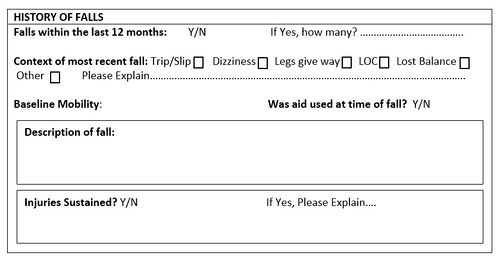The Single Strategy To Use For Dementia Fall Risk
Table of ContentsDementia Fall Risk Things To Know Before You BuyThe Definitive Guide for Dementia Fall RiskGetting My Dementia Fall Risk To WorkTop Guidelines Of Dementia Fall Risk
A fall danger assessment checks to see just how most likely it is that you will certainly fall. It is mostly done for older adults. The assessment typically includes: This includes a collection of questions regarding your total wellness and if you have actually had previous drops or problems with balance, standing, and/or strolling. These tools test your toughness, equilibrium, and stride (the way you stroll).STEADI includes testing, assessing, and intervention. Treatments are recommendations that might reduce your threat of falling. STEADI includes 3 steps: you for your danger of dropping for your risk variables that can be enhanced to attempt to avoid falls (for instance, equilibrium issues, impaired vision) to lower your threat of dropping by making use of efficient methods (for instance, offering education and resources), you may be asked numerous inquiries consisting of: Have you dropped in the past year? Do you feel unstable when standing or strolling? Are you fretted about falling?, your copyright will certainly examine your toughness, balance, and gait, using the following loss assessment tools: This examination checks your gait.
If it takes you 12 seconds or even more, it may suggest you are at greater risk for a fall. This examination checks strength and balance.
Move one foot halfway onward, so the instep is touching the huge toe of your various other foot. Move one foot completely in front of the various other, so the toes are touching the heel of your various other foot.
Things about Dementia Fall Risk
The majority of drops happen as a result of numerous contributing aspects; as a result, handling the risk of dropping starts with identifying the factors that add to fall danger - Dementia Fall Risk. A few of the most relevant threat aspects consist of: Background of previous fallsChronic medical conditionsAcute illnessImpaired stride and equilibrium, lower extremity weaknessCognitive impairmentChanges in visionCertain high-risk medications and polypharmacyEnvironmental aspects can also boost the danger for falls, including: Poor lightingUneven or damaged flooringWet or slippery floorsMissing or harmed hand rails and order barsDamaged or incorrectly equipped tools, such as beds, wheelchairs, or walkersImproper use of assistive devicesInadequate supervision of individuals residing in the NF, including those that display hostile behaviorsA successful fall risk management program needs a detailed scientific assessment, with input from all members of the interdisciplinary group

The treatment plan should also include treatments that are system-based, such as those that advertise a safe setting (appropriate illumination, hand rails, get hold of bars, and so on). The efficiency of the treatments must be examined periodically, and the treatment strategy revised as essential to show changes in the loss risk assessment. Executing a loss threat monitoring system utilizing evidence-based finest technique can decrease the occurrence of drops in the NF, while limiting the potential for fall-related injuries.
The 45-Second Trick For Dementia Fall Risk
The AGS/BGS standard advises evaluating all grownups matured 65 years and older for loss threat each year. This screening includes asking patients whether they have actually fallen 2 or even more times in the past year or looked for clinical focus for an autumn, or, if they have not fallen, whether they really feel unstable when walking.
Individuals who have actually dropped once without injury ought to Your Domain Name have their equilibrium and gait assessed; those with gait or equilibrium problems must obtain additional evaluation. A history of 1 fall without injury and without stride or balance issues does not call for additional analysis past ongoing yearly loss risk screening. Dementia Fall Risk. A loss threat evaluation is needed as part of the Welcome to Medicare evaluation

Dementia Fall Risk Fundamentals Explained
Documenting a drops background is just one of the top quality indications for autumn prevention and monitoring. An essential component of threat evaluation is a medication testimonial. Several courses of drugs raise autumn threat (Table 2). Psychoactive medications particularly are independent forecasters of falls. These medicines have a tendency to be sedating, change the sensorium, and impair balance and gait.
Postural hypotension can commonly be eased by minimizing the dose of blood pressurelowering medicines and/or stopping drugs that have orthostatic hypotension as a negative effects. Use of above-the-knee support hose pipe and this copulating the head of the bed raised might likewise minimize postural reductions in high blood pressure. The advisable elements of a fall-focused health examination are revealed in Box 1.

A pull time higher than or equivalent to 12 seconds suggests high fall risk. The 30-Second Chair Stand test assesses reduced see this extremity toughness and balance. Being unable to stand from a chair of knee elevation without using one's arms indicates increased loss danger. The 4-Stage Equilibrium examination analyzes fixed balance by having the patient stand in 4 positions, each considerably a lot more tough.
Comments on “The 6-Minute Rule for Dementia Fall Risk”